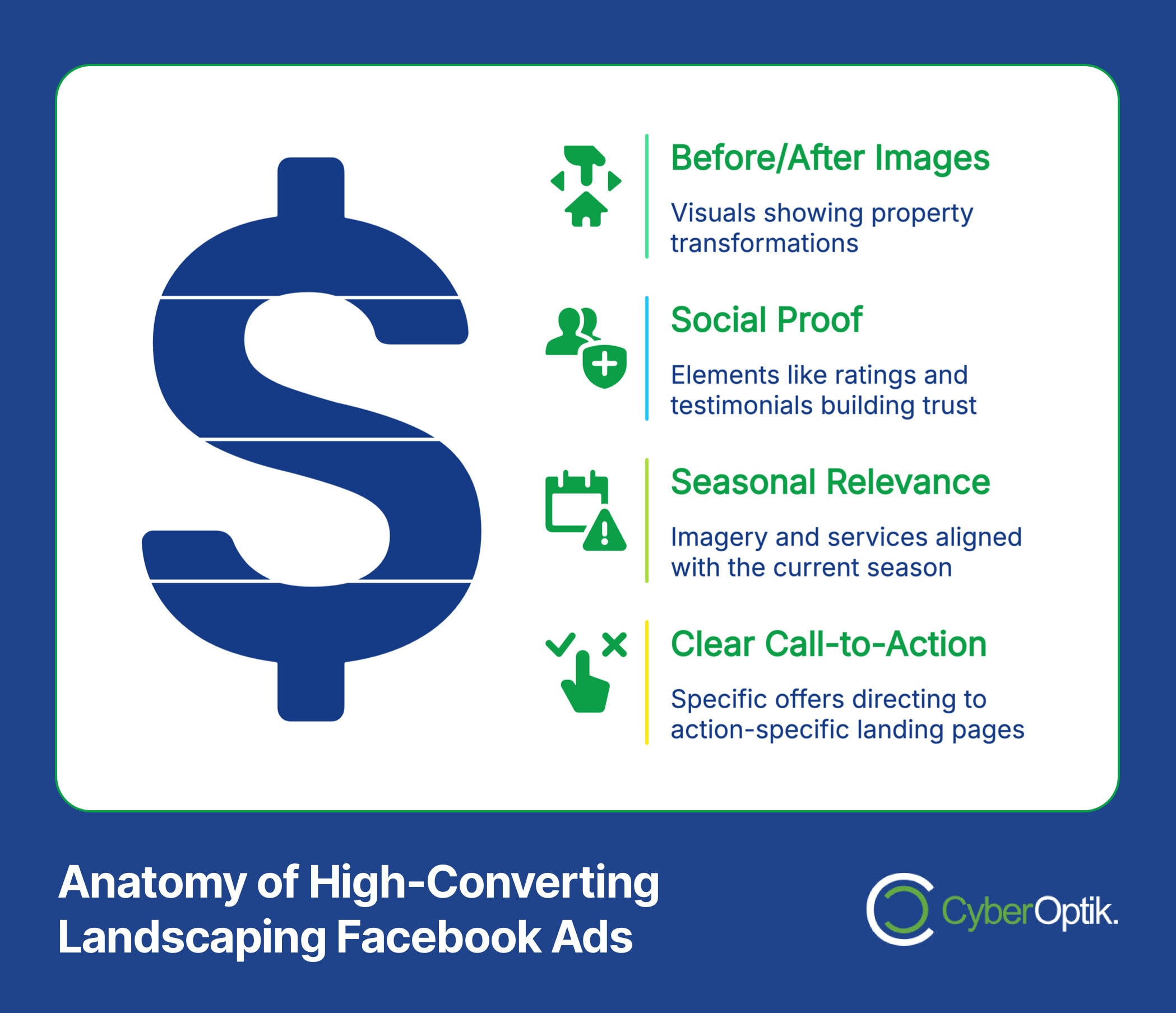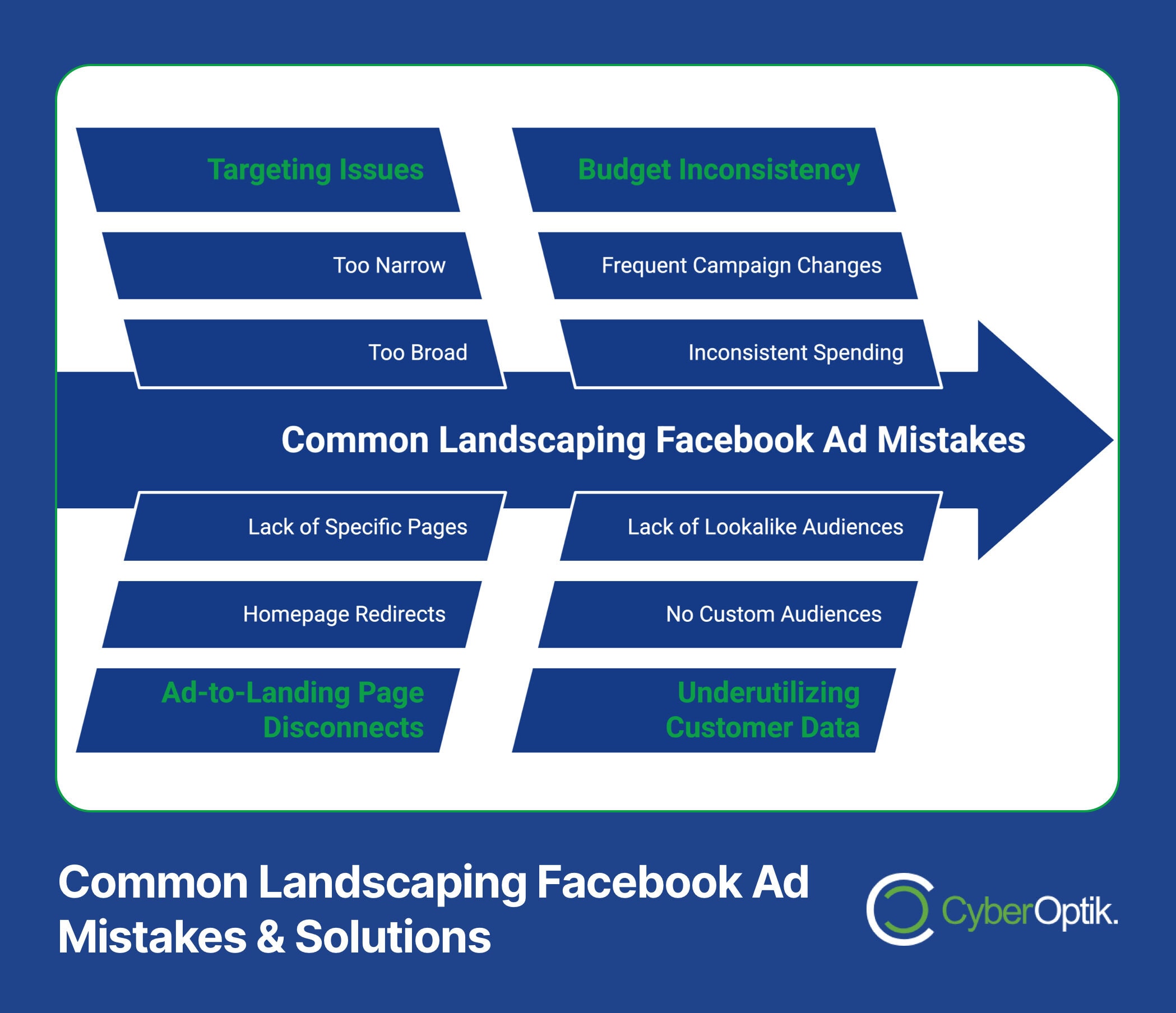Facebook provides exceptional marketing opportunities for landscaping businesses. With 70% of U.S. adults using Facebook, the platform offers unprecedented access to homeowners in need of landscaping services. (Source: Field Routes)
Standing out among competitors requires strategic ad design. Many landscaping businesses struggle to create Facebook ads that truly capture attention and drive conversions. The difference between mediocre and exceptional campaigns often comes down to a few critical elements.
In this guide, we’ll share proven strategies for creating landscaping Facebook ads that generate real results. From targeting the right audience to designing compelling visuals and optimizing landing pages, we’ll cover everything you need to know to elevate your landscaping business’s social media advertising.
Understanding the Landscape of Facebook Advertising for Landscapers
Facebook provides unique advantages for landscaping businesses. The platform’s visual nature perfectly showcases your work. Its targeting capabilities help you reach homeowners in your service area with precision.
Most landscaping businesses see a return on investment between 1-10% from their Facebook advertising campaigns, depending on factors like service offerings, local competition, and campaign effectiveness. (Source: Field Routes)
The cost structure makes Facebook accessible for businesses of all sizes. Lead generation campaigns for landscaping services have an average cost-per-click (CPC) of $0.59, making it a cost-effective channel compared to many traditional advertising methods. (Source: Field Routes)
Understanding these fundamentals helps set realistic expectations. Let’s look at how Facebook’s advertising ecosystem specifically applies to the landscaping industry.
| Facebook Metric | Landscaping Industry Benchmark | Strategic Implication |
|---|---|---|
| Average CPC | $0.59 for lead generation | Cost-effective for getting customer information |
| Typical ROI | 1-10% range | Reasonable returns with proper optimization |
| Platform Usage | 70% of U.S. adults | Large audience of potential customers |
| Best Campaign Types | Lead generation, conversion | Focus on collecting information and driving action |
These benchmarks provide a foundation for planning effective campaigns. Success depends on how well you implement the essential elements we’ll cover next.
Key Performance Metrics for Landscaping Facebook Ads
Tracking the right metrics ensures your ad spend delivers results. Click-through rate (CTR) indicates how compelling your ads are to your target audience. Conversion rate shows how effectively your landing pages turn visitors into leads.
Cost per lead (CPL) helps determine overall campaign efficiency. This figure varies based on location and service type, but provides a clear indicator of campaign performance. It allows you to calculate exactly how much you’re paying for each potential customer.
Return on ad spend (ROAS) measures the revenue generated relative to your advertising costs. For landscaping services, where customer lifetime value can be significant, even modest initial ROAS figures may indicate profitable campaigns when considering long-term customer relationships.
Essential Elements of High-Converting Landscaping Facebook Ads
Effective landscaping Facebook ads share common characteristics. They showcase visual transformation, highlight specific benefits, and include clear calls to action. The combination of these elements creates compelling ads that drive engagement.

Visual content plays a crucial role in landscaping ads. According to an analysis of over 37,000 Facebook ads, images that show “before and after” transformations significantly outperform generic stock photos. These visuals provide tangible proof of your capabilities. (Source: AdEspresso)
The most effective landscaping ads focus on seasonal relevance. Promoting the right services at the right time of year connects with homeowners when they’re most receptive. This alignment between offer and need drives higher conversion rates.
- High-quality project photos – Showcase real work with professional-quality images
- Clear value proposition – Communicate specific benefits, not just features
- Seasonal relevance – Align offers with current landscaping needs
- Social proof – Include ratings, reviews, or customer testimonials
- Compelling call-to-action – Guide users with specific next steps
These core components work together to create ads that capture attention and drive action. Let’s examine how to implement visual best practices next.
| Visual Element | Impact on Engagement | Implementation Tips |
|---|---|---|
| Before/After Images | Demonstrates transformation value | Use consistent angles, lighting, and composition |
| Videos of Projects | Shows process and attention to detail | Keep under 30 seconds, focus on results |
| Staff in Uniform | Builds trust and professionalism | Include team members working on properties |
| Property Close-ups | Highlights craftsmanship and quality | Show textures, materials, and design details |
Implementing these visual elements strategically enhances your ad performance. The right imagery creates immediate impact and communicates your quality standards.
Visual Best Practices for Landscaping Ads
Image quality matters tremendously. The best landscaping ads feature professional-grade photography that showcases the vibrant colors, textures, and details of completed projects. Poorly lit or blurry images suggest subpar work quality.
For landscaping businesses, seasonal imagery drives stronger results. Photos that match the current season or upcoming seasonal transition create urgency and relevance. They remind homeowners of immediate needs they may be experiencing or anticipating.
Including people enjoying beautifully landscaped spaces helps potential customers envision the lifestyle benefits. These emotional connections often drive decision-making more powerfully than purely functional appeals to property maintenance or value.
Compelling Copy Techniques for Landscaping Services
Effective ad copy addresses specific pain points. Homeowners worry about curb appeal, maintenance hassles, and property value. Acknowledging these concerns shows you understand their situation and have relevant solutions to offer.
Seasonal messaging drives urgency in landscaping advertising. Phrases like “Get your yard ready for summer entertaining” or “Prepare your property for winter” connect with immediate homeowner concerns. This timeliness increases conversion potential.
The most effective calls-to-action for landscaping businesses are specific and value-oriented. “Get Your Free Design Consultation” performs better than generic phrases like “Learn More” because it offers a tangible next step with clear value. (Source: Field Complete)
Targeting Strategies to Reach the Right Landscaping Customers
Precise targeting separates successful landscaping ads from wasted ad spend. Facebook’s platform offers multiple targeting dimensions that let you reach your ideal customers with remarkable precision.
Many landscaping companies make the critical mistake of using audiences that are too broad. While Facebook’s algorithm encourages expanding audiences, this approach often targets users with no interest in landscaping services. Focusing on specific ZIP codes and niche interests delivers better results. (Source: Landscape Marketing Pros)
Strategic targeting significantly impacts campaign performance. The right audience specifications can reduce cost per lead by focusing your budget on people most likely to become customers. This efficiency maximizes your advertising return on investment.
| Targeting Parameter | Recommended Settings | Business Impact |
|---|---|---|
| Geographic Radius | 10-15 miles from business location | Focuses on serviceable area, reduces travel costs |
| Home Ownership | "Homeowners" demographic filter | Eliminates renters who rarely purchase landscaping |
| Income Level | Top 50% income brackets | Targets those with budget for professional services |
| Life Events | "Recently Moved" filter | Reaches new homeowners needing landscaping |
These targeting parameters work together to define your ideal audience. Adjusting these settings based on performance data helps continuously improve your targeting precision.
Geographic and Demographic Targeting for Local Landscapers
Local service areas define your primary targeting boundary. Most landscaping businesses find optimal efficiency with a 10-15 mile radius from their base of operations. This geography balances reach with practicality in service delivery.
Age targeting helps reach decision-makers for landscaping services. The core audience typically falls between 35-65 years old, representing established homeowners with both the means and motivation to invest in professional landscaping. Younger demographics generally have lower conversion rates.
Income level targeting ensures you reach customers who can afford your services. Targeting the top 50% of income levels in your area focuses your budget on realistic prospects rather than aspirational browsers who may admire your work but lack the budget to hire professionals.
Interest and Behavior-Based Targeting for Landscaping
Interest-based targeting refines your audience further. Facebook users who follow home improvement shows, garden supply retailers, and outdoor living publications demonstrate relevant interests. These connections indicate higher potential interest in landscaping services.
One of the most effective targeting strategies for landscaping businesses involves using the “Recently Moved” behavior filter. New homeowners frequently need landscaping services to improve their property and often lack established relationships with local providers. (Source: Bristol Strategy)
Creating lookalike audiences based on your existing customers leverages Facebook’s algorithm effectively. This approach finds users with similar characteristics to people who have already purchased your services, expanding your reach to highly qualified prospects who share traits with your best customers.
Campaign Structure and Budget Optimization for Landscapers
Proper campaign structure dramatically affects Facebook ad performance. Organizing your campaigns by service category or seasonal focus creates clarity in budget allocation and performance tracking. This organization supports more strategic decision-making.
Landscaping businesses face unique seasonal considerations in budgeting. Allocating more resources during peak season inquiry periods maximizes opportunity, while maintaining minimal presence during off-seasons preserves audience connections. This approach aligns spending with business opportunity.
As landscaping businesses transition from Facebook’s traditional ad platform to the newer Meta ecosystem, understanding the structural changes becomes essential. The core advertising principles remain similar, but the interfaces and some targeting options have evolved. (Source: Service Autopilot)
| Campaign Level | Structuring Approach | Optimization Focus |
|---|---|---|
| Campaign | Organize by service type (lawn care, landscaping, hardscaping) | Align with business objectives |
| Ad Set | Segment by audience characteristics | Test different targeting approaches |
| Ad | Vary creative elements and offers | Identify highest-performing messages |
| Budget | Allocate based on service profitability | Maximize return on ad spend |
This structured approach to campaign organization provides clarity and supports optimization. It allows for targeted improvements based on specific performance data.
Seasonal Budgeting Strategies for Landscaping Ads
Seasonal demand patterns should guide budget allocation. For most regions, spring represents the highest demand period, followed by early fall. Increasing budgets during these windows captures peak interest, while reducing spend during winter months prevents waste.
Testing different budget levels reveals efficiency thresholds. Start with conservative daily budgets ($10-20 per day) and gradually increase based on performance. Track cost per lead at each spending level to identify the point of diminishing returns.
Budget flexibility enables response to weather patterns. Unexpected early springs or extended fall seasons create additional demand windows. Having contingency budgets allows you to capitalize on these opportunities when they arise.
Going Deeper
Discover how service contractors can implement comprehensive digital marketing strategies that combine social media, SEO, and website optimization for maximum lead generation.
Landing Page Optimization for Landscaping Ad Campaigns
Landing page quality directly impacts conversion rates. Facebook users who click your ads have specific expectations based on what they’ve seen. Your landing page must deliver a cohesive continuation of that initial promise to convert effectively.
A common critical mistake many landscaping companies make is directing Facebook ad traffic to their homepage rather than dedicated landing pages. This practice significantly increases bounce rates as visitors struggle to find the specific information promised in the ad. (Source: Halstead Media)
Effective landscaping landing pages focus on a single offer or service. This targeted approach maintains visitor attention and guides them toward a specific conversion action. The clarity increases both conversion rates and lead quality.
| Landing Page Element | Best Practice for Landscapers | Conversion Impact |
|---|---|---|
| Hero Image | Show completed project relevant to ad | Creates visual continuity and trust |
| Headline | Match or closely align with ad headline | Confirms visitors found right information |
| Social Proof | Include reviews specific to advertised service | Builds confidence in hiring decision |
| Lead Form | Keep to 3-5 fields maximum | Reduces friction in conversion process |
Implementing these landing page elements creates a cohesive user experience. The alignment between ad and landing page significantly improves conversion rates for landscaping businesses.
Creating Dedicated Landing Pages That Convert
Visual consistency between your ads and landing pages builds trust. Using the same images, color schemes, and messaging creates a seamless transition. This continuity reassures visitors they’ve arrived at the right place after clicking your ad.
For landscaping businesses, showcasing relevant portfolio examples on landing pages significantly increases conversion rates. Including 3-5 examples of similar projects demonstrates your capability and helps prospects visualize results for their own property.
Simplified contact forms perform best for landscaping leads. Requesting only name, phone, email, and project type balances your need for qualification information with the user’s desire for convenience. Each additional field can reduce conversion rates by approximately 4%. (Source: Lawn & Landscape)
Measuring Success: Analytics and Tracking for Landscaping Ads
Proper measurement creates the foundation for optimization. Without accurate tracking, determining which ads and targeting strategies actually generate business becomes impossible. This data vacuum leads to continued investment in underperforming approaches.
The Meta Pixel serves as the crucial link between ad clicks and website actions. Setting up this tracking code enables you to monitor conversions and build retargeting audiences of previous visitors. This capability dramatically increases campaign effectiveness over time.
Beyond immediate conversions, landscaping businesses must track longer customer journeys. The typical buying cycle for significant landscaping projects spans multiple weeks and involves several touchpoints. Understanding this multi-touch attribution provides a more accurate view of campaign performance.
| Analytics Metric | Target Benchmark | Optimization Action |
|---|---|---|
| Click-Through Rate (CTR) | 1-2% or higher | Improve ad creative if below benchmark |
| Landing Page Conversion | 10-15% | Refine landing page if below target |
| Cost Per Lead (CPL) | Varies by market ($20-50) | Adjust targeting if consistently above target |
| Lead-to-Customer Rate | 15-25% | Improve lead qualification if below benchmark |
Tracking these metrics provides a comprehensive view of campaign performance. Regular monitoring allows for timely optimizations that continuously improve results.
Setting Up Conversion Tracking for Landscaping Services
Define clear conversion events that align with business goals. For most landscaping businesses, key conversions include contact form submissions, phone calls, and estimate requests. Tracking these specific actions provides relevant performance data.
Proper conversion value assignment improves optimization. Different lead types have varying business value—a full landscape design inquiry typically holds more value than a lawn maintenance request. Assigning appropriate values enables Facebook’s algorithm to optimize for higher-value conversions.
Digital marketing experts recommend implementing phone call tracking to close a common measurement gap. Many landscaping customers prefer calling, especially for urgent needs. Call tracking solutions integrated with Facebook’s platform provide complete visibility into this important conversion channel. (Source: Jay Scotts)
What does your website’s exit rate reveal about your Facebook ad effectiveness when examining landing page performance? High exit rates often indicate a disconnect between ad promises and landing page delivery.
Pro Tip
According to research from the landscaping industry, social media marketing strategies that combine both organic content and paid advertising perform significantly better than either approach alone. (Source: Service Autopilot)
The Role of Ad Creative Testing in Improving Results
Systematic testing dramatically improves campaign performance. A/B testing different images, headlines, and offers reveals what resonates best with your target audience. This data-driven approach eliminates guesswork and builds on proven success.
For landscaping businesses, testing different visual styles often yields surprising insights. While before-and-after transformations typically perform well, variations in composition, lighting, and featured elements can significantly impact engagement rates. Testing helps identify the specific visual approaches that work best for your particular services.
Facebook’s built-in testing tools make creative optimization accessible. The platform’s A/B testing features allow you to systematically compare ad variations and receive statistically valid results about which performs better. Companies that consistently test their ad creative typically see 20-30% better performance over time. (Source: Invoca)
| Test Element | Testing Approach | Performance Impact |
|---|---|---|
| Image Type | Compare before/after vs. completed projects | Can affect CTR by 20-50% |
| Ad Headline | Test benefit-focused vs. question-based | Can impact engagement by 10-15% |
| Call to Action | Compare direct ("Get Quote") vs. softer approaches | May influence conversion rates by 5-10% |
| Offer Type | Test discount vs. free consultation vs. added value | Can affect lead quality and closing rates |
A structured testing program reveals what truly works for your specific business. The insights gained from proper testing lead to continuously improving performance metrics over time.
Common Mistakes Landscaping Companies Make With Facebook Ads

Budget inconsistency undermines campaign success. Many landscaping companies start and stop campaigns frequently, preventing Facebook’s algorithm from optimizing properly. Consistent budget allocation, even at modest levels, produces better results than sporadic large investments.
Experts identify targeting errors as the most common issue in landscaping Facebook campaigns. Many businesses target too broadly, wasting budget on people unlikely to purchase, or too narrowly, missing potential customers. Finding the right balance requires ongoing refinement. (Source: Halstead Media)
Many landscaping businesses fail to leverage the power of customer data. Not uploading customer email lists for custom and lookalike audiences represents a missed opportunity. These audience types typically deliver the highest conversion rates and lowest cost per lead compared to interest-based targeting.
Creating effective Facebook ads for landscaping businesses requires attention to multiple factors. The right targeting ensures your budget reaches potential customers. Compelling visuals and copy communicate your value proposition. Optimized landing pages convert interest into action.
The foundation of success lies in measurement and continuous improvement. By tracking key metrics and making data-driven optimizations, you can steadily improve performance and ROI from your Facebook advertising efforts.
At CyberOptik, we help landscaping businesses implement these strategies as part of comprehensive digital marketing campaigns. Our approach combines Facebook advertising with strategic SEO for landscaping companies and web design to create complete digital ecosystems that generate consistent leads.
Ready to take your landscaping Facebook ads to the next level? Contact our team today for a consultation on how we can help your business stand out and attract more qualified leads through strategic digital marketing.




